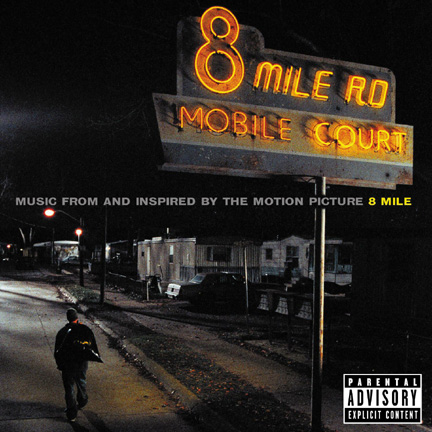
Office: HGH 210; phone: (408) 924-5378
Email: wooda@email.sjsu.edu
Web: http://www.sjsu.edu/faculty/wooda
 |
Dr. Andrew Wood Office: HGH 210; phone: (408) 924-5378 Email: wooda@email.sjsu.edu Web: http://www.sjsu.edu/faculty/wooda |
Watts, E. K. (2005). Border patrolling and "passing" in Eminem's 8 Mile. Critical Studies in Media Communication, 22(3), 186-206.
Note: These comments are not designed to "summarize" the reading. Rather, they are available to highlight key ideas that will emerge in our classroom discussion. As always, it's best to read the original text to gain full value from the course.
 Watts
examines various personae created by Marshall Mathers (aka Eminem, aka “Rabbit”
in 8 Mile), and the singer’s efforts to establish his identity
as a hip-hop performer. To be sure, these efforts were bound to face resistance:
“As a white artist, Mathers has had to contend with the racial bias associated
with performing in a traditionally urban African American musical genre”
(p. 188). To this struggle, Eminem offers his semi-biographical film, 8
Mile in which he appears “as both racially distinctive and as possessing
universal commercial appeal” (p. 189). Watts develops this thesis, first,
by exploring the study of whiteness in America.
Watts
examines various personae created by Marshall Mathers (aka Eminem, aka “Rabbit”
in 8 Mile), and the singer’s efforts to establish his identity
as a hip-hop performer. To be sure, these efforts were bound to face resistance:
“As a white artist, Mathers has had to contend with the racial bias associated
with performing in a traditionally urban African American musical genre”
(p. 188). To this struggle, Eminem offers his semi-biographical film, 8
Mile in which he appears “as both racially distinctive and as possessing
universal commercial appeal” (p. 189). Watts develops this thesis, first,
by exploring the study of whiteness in America.
To Watts, whiteness
studies provides a means to interrogate a subject position that has
previously escaped criticism. The word “position” is critical, indicating
the use of geography as a metaphor within these studies. From this perspective,
whiteness becomes powerful, not because of its position but because of its lack
of position. Thus, whiteness is centered but invisible: “Signifying a
spatial relation to ‘others’ who are positioned as satellites of
a white world. These definitions mark the boundaries of racial geography”
(p. 190). Watts then turns to the role of myth in the construction of
whiteness, suggesting that the white “spirit” must overcome
its “dark elements” in order to “transcend the limitations
of the flesh” (p. 191). This mythic struggle emerges from the perception
of a continual threat to white “purity.”: “And so, master
narratives that pursue mythic whiteness often pit white men against feminized
dark forces from within and without the white body as tests of immanent manhood”
(p. 191). Following this review, Watts argues that some mythic narratives mark
a transition from a subject who is “‘discursively black’ and
potentially white” (p. 192) - setting up his analysis of 8 Mile.
This analysis identifies key images and scenes of dialogue to illustrate what
Watts describes as Rabbit’s transformation from fragmented submersion
into blackness to his final, triumphant assertion of whiteness. Initially, Watts
illustrates Rabbit’s status as a “white negro” by noting to
character’s feminized position when he “chokes” at a battle:
“The film has now dramatized the injury to white masculinity as a form
of sexual dysfunction” (p. 193). Both he and his microphone hang limp
at the end of the scene, suffering from performance anxiety (p. 194). Worse
yet are Rabbit’s encounters with women.
Watts describes how Rabbit is further confronted with “dark white women”
who also must be overcome. Initially. Rabbit’s mother depicts the fallen
women who causes or exacerbates the hero’s impotence. Later, Rabbit’s
“dark lover” must also be confronted. Not too surprisingly, “[s]urrounded
by beautiful black women, this discursively dark white man only has eyes for
a discursively dark white women” (p. 196). But, eventually, she is revealed
as merely an instigator to “mythic white masculinity” by her flaws,
not her virtues (p. 197). At this point, Watts turns more directly to the problem
of Rabbit “passing” as a black man.
This analysis focuses here on Rabbit’s camaraderie with a (largely) black
cast of friends, comparing that crew (the 313rd) with a more clearly archetypal
sign of “dangerous” blackness, the Free World. This group represents
how “Black power has run amok; it is abusive, hegemonic, and oppressive”
(p. 199). Of course, such a threat must be faced - in the battle that marks
the film’s crescendo. In this battle, Rabbit faces marginalization as
a white guy who inappropriately crosses the “mile” to occupy black
space. In response, Rabbit enacts the mythic notion that (even) a rapper should
be judged by the content of his character rather than the color of his skin.
Moreover, he affirms his value as “white trash” in a manner that
stabilizes his identity, even as “The Free World is vanquished as white-like”
for having a leader from the suburbs (p. 202). Ultimately, Rabbit departs the
scene. After all, “at the film’s end . . . the color line must be
maintained in order for his passing to be heroic” (p. 202). Watts concludes
with a comment about how 8 Mile, despite its supposed affection for
black culture seems to imply that some things - like economic disadvantage for
African Americans - should never change.
[Return to Syllabus]